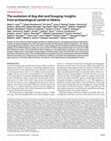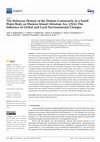Papers by Arkady Savinetsky
Archaeofauna, Jan 10, 2024
ARCHAEOFAUNA es una revista anual que publica trabajos originales relacionados con cualquier aspe... more ARCHAEOFAUNA es una revista anual que publica trabajos originales relacionados con cualquier aspecto del estudio de restos animales recuperados en yacimientos arqueológicos. Los manuscritos deben enviarse a: Índices/Contents Gift of the Mamelukes: Animal ambassades as vectors of exotic fauna introductions in the Spanish Middle Ages. El regalo de los mamelucos: Las embajadas animales como vectores de introducciones de fauna exótica en la Edad Media española.

Science Advances
Research on the evolution of dog foraging and diet has largely focused on scavenging during their... more Research on the evolution of dog foraging and diet has largely focused on scavenging during their initial domestication and genetic adaptations to starch-rich food environments following the advent of agriculture. The Siberian archaeological record evidences other critical shifts in dog foraging and diet that likely characterize Holocene dogs globally. By the Middle Holocene, body size reconstruction for Siberia dogs indicates that most were far smaller than Pleistocene wolves. This contributed to dogs’ tendencies to scavenge, feed on small prey, and reduce social foraging. Stable carbon and nitrogen isotope analysis of Siberian dogs reveals that their diets were more diverse than those of Pleistocene wolves. This included habitual consumption of marine and freshwater foods by the Middle Holocene and reliance on C 4 foods by the Late Holocene. Feeding on such foods and anthropogenic waste increased dogs’ exposure to microbes, affected their gut microbiomes, and shaped long-term dog ...
Radiocarbon
ABSTRACTWe present an overview of the beginning and early years of radiocarbon dating in Russia. ... more ABSTRACTWe present an overview of the beginning and early years of radiocarbon dating in Russia. Achievements of several major scholars in this field from Leningrad (St. Petersburg), Moscow and Novosibirsk are briefly described. The existing and closed Russian laboratories are also mentioned.
Biology Bulletin, 2021
An Erratum to this paper has been published: https://doi.org/10.1134/S1062359021660018

Ethiopian Journal of Biological Sciences, 2017
This paper presents results of the multiproxy palaeoenvironmental study of three zoogenic deposit... more This paper presents results of the multiproxy palaeoenvironmental study of three zoogenic deposits, situated at the different altitudes in the Bale Mountains (South-central Ethiopia). Radiocarbon dating, pollen and diatom analyses were used to reconstruct the ecosystems‟ dynamics of the Bale Mountains during the Late Pleistocene and the Holocene. Pollen analysis revealed signals of the African Humid Period (AHP) and specified its precise time (15,000−4,600 cal yrs BP). The Weyib valley remained relatively arid from 15,000 to 8,600 cal yrs BP. A short humid period commenced at 8,500−8,000 cal yrs BP. Gradual climate aridization took place since 8,000 cal yrs BP. Diatom data show that the Sanetti plateau was relatively wet during the past 7000 years with some fluctuations in moisture. The plateau experienced more oxygenated systems after 2,500 cal yrs BP until now than before due to the creation of new lakes that indicate a humid climatic regime. The Weyib valley experienced a relativ...

Water, 2021
A diatom analysis of a peat deposit from Shemya Island (Aleutian Arc, USA) is performed, and the ... more A diatom analysis of a peat deposit from Shemya Island (Aleutian Arc, USA) is performed, and the dynamics of the diatom community are described. According to the radiocarbon dating, the formation of the deposit began 9300 cal. years BP. Principal component analysis made it possible to relate the dynamics of the diatom community to certain environmental conditions and the factors that influenced the coastal ecosystems during its formation. The following factors (predictors) were considered: the influence of age, zoo- and anthropogenic effects, and changes in climatic conditions. Sea level change was the main driver of the diatom community in the studied water body having a continuous direct and indirect influence on the studied small water body, i.e., by bird colony formation and more humid and coastal conditions. Since 3000–2000 cal. years BP, the anthropogenic factor (hunting depression of the bird colony) also became significant. During the whole water body lifetime and following ...
Tree-Ring Research, 2021
ABSTRACT New oak tree-ring chronologies for European Russia built with subfossil oak wood excavat... more ABSTRACT New oak tree-ring chronologies for European Russia built with subfossil oak wood excavated from the alluvial deposits of the Zapadnaya Dvina (Daugava) River and archaeological samples from Novgorod and Vyazma are presented. They have been matched with the nearest absolutely dated tree-ring chronology constructed in Polotsk (Republic of Belarus) and dated to the periods AD 649–1382 (Zapadnaya Dvina), AD 1059–1386 (Novgorod), and AD 1074–1306 (Vyazma). Dates have been further confirmed via comparison with subfossil oaks from Smarhon (Republic of Belarus) and Baltic 1 chronology as well as by radiocarbon dating. Newly built medieval chronologies can be used for dating and provenancing of oak wood originating from archaeological sites and natural archives.
Зоологический журнал, 2019
Biology Bulletin, 2018
⎯The results of spore-pollen analysis and analysis of non-pollen palynomorphs of the Katcha zooge... more ⎯The results of spore-pollen analysis and analysis of non-pollen palynomorphs of the Katcha zoogenic deposit, located in the Harenna Forest (Bale Mountains National Park, Ethiopia) are presented. It is revealed that bamboo monodominant communities have inhabited areas at altitudes of 2700-2800 m above sea level for at least the past 6500 years. A trend towards a decrease in bamboo communities due to climate aridization in the last 5000 years has been revealed. It is established that active human impact on these ecosystems began 1000 years ago.
Doklady Biological Sciences, 2016
Doklady biological sciences : proceedings of the Academy of Sciences of the USSR, Biological sciences sections / translated from Russian, 2014

Зоологический журнал, 2013
ABSTRACT The results of identifying the fish remains from two archaeological sites on Adak Island... more ABSTRACT The results of identifying the fish remains from two archaeological sites on Adak Island (Aleutian Islands, Alaska) are represented. The main objectives were to determine the main fish groups in catches of ancient Aleuts and temporal dynamics of their relative abundance and individual size. Settlers of an ancient settlement on the Clam Lagoon coast (archaeological site ADK�171, circa 6500 cal. years BP) caught greenlings (Hexagrammos sp.) and small�scale gadids, mainly saffron cod (Eleginus gracils). Owing to changes in the substrate of the Clam Lagoon, the share of flatfish in catches became higher. No dynamics in the shares of greenlings and saffron cods were observed. Ancient Aleuts from the settlement in the Sweeper Cove (1400–200 cal. years BP) also caught greenlings and gadids, mainly large Pacific cod (Gadus macrocephalus). During this period, the shares of Pacific cod in the catches significantly decreased; on the contrary, those of greenlings increased. A relative abundance of Pacific cod in the Sweeper Cove region grew also during the period studied, and the relative abundance of greenlings was reduced. All changes in shares and relative abundance coincided with the main climatic shifts in the North Pacific region. The intense fishing of greenlings affected the local greenling population during the existence of the settlement in the Sweeper Cove region.
Le Centre pour la Communication Scientifique Directe - HAL - SHS, 2010
Le Centre pour la Communication Scientifique Directe - HAL - SHS, 2012











Uploads
Papers by Arkady Savinetsky